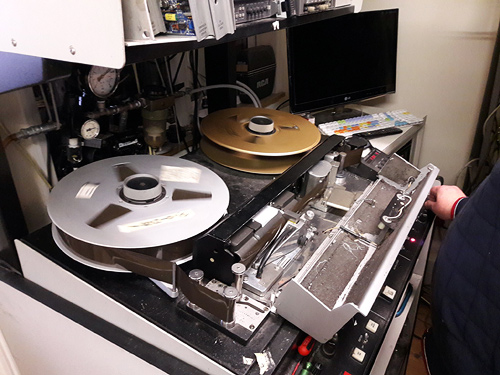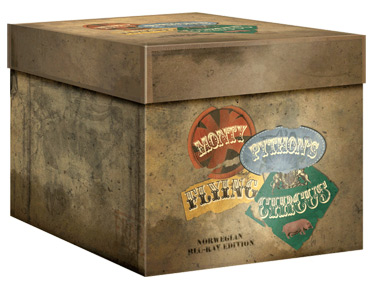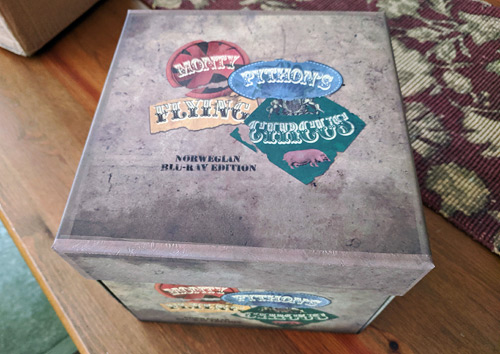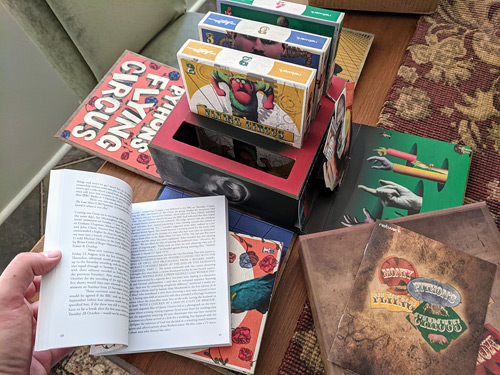Monty Python’s Flying Circus: Norwegian Blu-ray Limited Edition (Blu-ray Review)

Director
Ian MacNaughton, John Howard DaviesRelease Date(s)
1969-1974 (November 4, 2019 – UK, November 12, 2019 – US)Studio(s)
BBC (Network Distributing Limited)- Film/Program Grade: A
- Video Grade: A
- Audio Grade: B
- Extras Grade: B+
- Overall Grade: A
Review
[Editor’s Note: The following review is now updated to include a look at Network’s complete and final product box set.]
The discovery of Monty Python’s Flying Circus was certainly a key moment in my life as a teenager. It ran on PBS stations here in the States in the mid-to-late 70s and early 80s, so it completely escaped the efforts of many a parent to censor the TV viewing of their children. After all, how could the network of Sesame Street, The Electric Company, and Zoom possibly show anything offensive to young sensibilities? And yet, when you clicked around the dial at the right time (often clued in by friends at school) there it was: Off-the-wall absurdity, slapstick, high-brow jokes you sometimes had to crack an encyclopedia to fully appreciate, crazy animations unlike anything seen elsewhere on TV at the time, and even the odd bit of nudity. Older audiences would, of course, have recognized some of this from Vaudeville, and comedians like Benny Hill and Spike Milligan, but for teens, Python was really the first taste of such humor. The only thing even close to it on American TV at the time was Saturday Night Live and SCTV, yet Python represented a whole different level of comedy sophistication.
The BBC teaming of upstart young British stage comics Graham Chapman, John Cleese, Eric Idle, Terry Jones, and Michael Palin—joined by the American animator Terry Gilliam—was not an obvious one. But following in the footsteps of Beyond the Fringe (a stage comedy review featuring Peter Cook, Dudley Moore and others), That Was the Week That Was (a BBC comedy show by David Frost that included Cleese and Chapman as writers), At Last the 1948 Show (which starred Marty Feldman as well as Cleese and Chapman), and Do Not Adjust Your Set (a kids show that included Idle, Palin, and Jones, with animations by Gilliam), Monty Python was something new. The style the group developed was sketch comedy where the sketches never needed to have a punchline; they could simply flow from one absurd idea to the next, often joined by Gilliam’s animations. The comedy itself was a unique mix of silly and surreal, sometimes bawdy (and occasionally un-PC by today’s standards), often intellectual, but always meant as a send-up of British establishment. The show lasted for four seasons (or series, in the UK vernacular)—45 episodes in all—and spawned five films (among them Monty Python and the Holy Grail, Monty Python’s Life of Brian, and Monty Python’s The Meaning of Live), along with live shows, TV specials, books, and comedy albums.
Network Distribution’s HD restoration of Monty Python’s Flying Circus has been nothing less than a herculean effort. The goal for this project was to create the most complete version of the series’ episodes possible, and to present them in the highest possible quality on Blu-ray. The box set’s insert booklet includes the following remastering notes:
“Monty Python’s Flying Circus was produced on 2” Quad tape as a mixture of studio sequences (shot on video cameras) with 16mm live action and animation film insert segments. The basis for this restoration were the earliest generation tapes—or direct copies of them—with the studio sequences being re-graded and restored, removing video drop-out (horizontal lines) as well as scratching (multiple smaller horizontal lines) and any severe faults like off-lock (complete picture break-up). Once restored, the programme then was up-scaled to High Definition.
“Surviving live action film for the series was sporadic, with 16mm original negative being available for only a few episodes for series 1 to 3 but existing for all episodes of series 4. Many of the other live action sequences were available on 16mm print but the condition was very poor with severe colour fading, inferior film joins and general damage that required many additional hours of grading and restoration. For the animation sections, there was more 16mm footage available on negative (as well as print) and these were scanned in HD, graded and restored before being dropped into the episode timeline to replace the archive transfers used for the original broadcast. Any dissolves through to VT were re-created and any text captions overlaid. The iconic main titles for all series did still exist on 16mm negative and were painstakingly restored and graded for use throughout the respective series.”

In a recent interview with TV Technology, the project’s restoration colorist, Jonathan Wood, described the effort thusly: “You’ve got the original quad tapes; you’ve got 16 millimetre film; you’ve got neg and prints; you’ve got 35 millimeter; you’ve got some bits only available in NTSC; you’ve got some film recording that we’re doing color recovery on. We’ve got everything you can think of. And that’s not unexpected because that is the era of the material. It just means it’s a very complicated puzzle to put together. And the trouble is, if you take those raw tapes and you just upscale them and put them on one of these modern screens, you’re going to see all the faults. You’re going to see all the noise, the dropouts, the flashes, the field phase areas, chroma areas, all sorts of things. And that’s not what it’s about; this is about getting the best presentation of these episodes as possible in a high-definition format. When you have dealt with the faults, you’ve got rid of the flashes, the dropout, the dirt, you may have improved the color; what you’re left with is just the performance.”
Network presents these fully remastered episodes in pillar-boxed HD at the original 1.33:1 TV broadcast ratio. Two versions of this Blu-ray release have been created: 60i (59.94i) for NTSC countries and 50i for PAL. (I’ve reviewed the 60i—if you order from direct from Network, you’ll be sent the appropriate version for your region based on your mailing address. If you purchase from Amazon US you’ll get 60i, likewise Amazon UK customers will get the 50i.) The overall level of quality is certainly remarkable, not just the newly film-scanned material but even the original PAL video. Color is more vibrant, accurate, and stable than ever before. Clarity is impressive too, with little to complain about but the odd bit of analog contrast haloing or aliasing, both relatively minor. Video material obviously isn’t as good as native HD; it certainly retains its soft, analog SD character, but the upsampling is impressive—enough so that when the image cuts to film, the transition isn’t jarring at all. As for the film-based content, there’s detail in the animations you’ve never seen before. I’ve been watching these episodes on a 110" projection screen and I am really impressed.
And here’s a great little touch: If you start playing episodes from the disc menu, each begins just as you remember them. But you might notice that the episodes start at Chapter 2—if you skip back from there, Network has actually included the original BBC studio VT clock leaders at the front of each episode! Studio portions of the show were actually recorded in front of a live audience, and you can hear the stage manager counting down to the start of the broadcast and sometimes the warm-up comic wrapping up. Occasionally, one of the Pythons can be heard joking with the audience as well.

Audio is included on the Blu-rays in 48K/16-bit English LPCM 2.0 mono. It’s nothing remarkable of course, but the sound quality is certainly as clear and clean as you’ve ever heard it. Optional subtitles are available in English, French, German, Spanish, Polish, and Portuguese.
Here’s what you get on this set’s 7 Blu-ray Discs, broken down by episodes and features. Again, this is the most complete and uncensored version of the series to date. Episodes that feature reinstated content are noted as such below, and I’ve compared the Blu-rays to the previous A&E 16-Ton Megaset DVDs to determine what was restored as accurately as possible:
Season One – Disc One
- Whither Canada? (31:47)
- Sex and Violence (includes reinstated content: David Frost phone number) (33:31)
- How to Recognise Different Types of Trees From Quite a Long Way Away (31:26)
- Owl Stretching Time (29:37)
- Man’s Crisis of Identity in the Latter Half of the 20th Century (29:20)
- It’s the Arts (30:00)
- You’re No Fun Anymore (30:16)
Season One – Disc Two
- Full Frontal Nudity (29:26)
- The Ant, an Introduction (29:09)
- Untitled (30:59)
- The Royal Philharmonic Orchestra Goes to the Bathroom (31:16)
- The Naked Ant (31:54)
- Intermission (29:49)
Season One – Disc Two also includes the following extras (all in HD):
- Sex and Violence: Studio Outtakes (10:08)
- Full Frontal Nudity: Studio Outtakes (7:03)
- The Ant, An Introduction: Studio Outtakes (5:05)
- Untitled: Extended Ron Obvious Filmed Material and Clean End Titles (9:30)
All of this content appears to have been cleaned up and upsampled as well. It involves little outtakes moments, sometimes without video or without audio—little odds and ends that must have been on the studio masters. The Sex and Violence footage includes multiple (and very funny) takes of Cleese and Palin performing the French Lecture on Sheep-Aircraft as their moustache keeps falling off. The Full Frontal Nudity clip features random little outtakes and retakes. The Ant, An Introduction is interesting as it features unused bits of Palin and Jones vamping in the Homicidal Barber sketch, including their banter between takes. And the Ron Obvious material is terrific, as it appears to be all of the original filmed material actually scanned from film in very high quality, including a few bits for which no audio exists (subtitles are included instead). It’s fascinating material as it gives you a better sense of what the production process was like in the studio during production.
Season Two – Disc One
- Face the Press (30:36)
- The Spanish Inquisition (30:41)
- Déjà Vu (30:26)
- The Buzz Aldrin Show (30:29)
- Live from the Grill-O-Mat (30:19)
- It’s a Living (includes reinstated content: Cancer reference) (29:45)
- The Attila the Hunt Show (27:58)
Season Two – Disc Two
- Archaeology Today (30:07)
- How to Recognise Different Parts of the Body (includes reinstated content: heavy breathing & The Girl from Ipanema song) (30:45)
- Scott of the Antarctic (30:21)
- How Not to Be Seen* (includes reinstated content: Satan animation) (30:04)
- Spam (30:51)
- Royal Episode 13 (30:34)
*(The cancer reference deleted from this episode has not been restored, but it is included in the extras on Season Two – Disc Two as an extended scene.)
Season Two – Disc Two also includes the following extras:
- The Buzz Aldrin Show: Extended and Unused Filmed Material (2:38)
- Live from the Grill-O-Mat: Extended Ken Clean-Air System (9:09)
- It’s a Living: Extended Election Night Special (6:58)
- It’s a Living: Extended School Prizes (4:07)
- It’s a Living: Censored Audio (1:32)
- How to Recognise Different Parts of the Body: Censored Audio (1:52)
- Scott of the Antarctic: Extended Filmed Material (16:34)
- How Not to Be Seen: Extended Conquistador Coffee (3:22)
- How Not to Be Seen: Unused Filmed Material (2:31)
- And Now For Something Completely Different: Vic Jamison’s 1970 Student Film (12:13)
- 1971 Interview with Ian MacNaughton (29:24)
The various unused filmed segments are just that—extra bits of scenes shot on 16mm film for use in the episodes, but not. Sketches from several episodes are presented in extended versions, as they were originally finished prior to editing for broadcast (the cuts being made for various reasons including time, censoring, clarity, etc). The It’s a Living audio clip preserves the censored version of the segment with the word “gangrene” dubbed over the original “cancer” reference. Likewise, the How to Recognise Different Parts of the Body audio clip preserves the classical music used in the censored version of the episode in place of the original heavy breathing. This package also includes the 1970 student film shot by Vic Jamison about the Pythons on set during the the making of the show (it includes interview clips and rare behind the scenes material). Finally, there’s a 1971 audio recording of an interview of the show’s producer/director, Ian MacNaughton, conducted at Imperial College London and set to a montage of period photographs. He provides a number of interesting anecdotes on the show and its production.
Season Three – Disc One
- Whicker’s World (31:17)
- Mr & Mrs Brian Norris’ Ford Popular (29:33)
- The Money Programme (29:11)
- Blood, Devastation, Death, War, and Horror* (30:22)
- The All-England Summarize Proust Competition (reinstated content: masturbating reference) (31:08)
- The War Against Pornography (28:48)
- Salad Days (reinstated content: Biggles Dictates a Letter fixed dialogue) (29:08)
*(The brief bit of Tonight from West Side Story originally sung in this episode by Graham Chapman has not been restored, no doubt due to rights issues, but it is included in the extras on Season Three – Disc Two as an extended scene.)
Season Three – Disc Two
- The Cycling Tour (31:25)
- The Nude Organist (reinstated content: German commercial animation parody) (32:07)
- E Henry Thripshaw’s Disease* (28:19)
- Dennis Moore (31:52)
- A Book at Bedtime (reinstated content: Party Political Broadcast (Choreographed) and Dad’s Doctors, Dad’s Pooves and Other Interesting Stories) (28:58)
- Grandstand (28:41)
*(Three sketches filmed for this episode but infamously censored by the BBC before broadcast – Big Nosed Sculptor, Revolting Cocktails, and Wee-Wee Wine Cellar – have not been found and are presumed lost. However Terry Gilliam’s censored animations from this episode are included in the extras on Season Three – Disc Two.)
Season Three – Disc Two also includes the following extras:
- Whicker’s World: Extended Mrs Premise & Mrs Conclusion Filmed Material (1:54)
- Blood, Devastation, Death, War, and Horror: Bus Conductor Extended Scene (3:02)
- Blood, Devastation, Death, War, and Horror: Extended Pantomime Horse Filmed Material (6:32)
- The Nude Organist: Studio Outtakes (8:13)
- The Nude Organist: Alternative Terry Gilliam-Approved Sound Mix (32:07)
- E Henry Thripshaw’s Disease: Extended Gay Boys in Bondage Animation (1:55)
- E Henry Thripshaw’s Disease: Extended Sir Philip Sidney Filmed Material (1:35)
- Dennis Moore: Extended Redistribution of Wealth Filmed Material (3:33)
- A Book at Bedtime: Original Opening (:56)
- A Book at Bedtime: Extended Heath Tango Animation (:20)
- Grandstand: Extended Grandstand Filmed Material (1:31)
- Grandstand: Extended Chairwoman Animation (2:24)
- Grandstand: Unused Betty Blood Donor Animation (1:26)
- Grandstand: Studio Outtakes (7:48)
- Series 3 Monologue Rushes (Mostly Mute) (6:02)
Once again, you get a wealth of unused location film material, extended versions of sketches trimmed for various reasons prior to broadcast, and rare, censored, and unused Terry Gilliam animations. A unique addition is the “Gilliam-approved sound mix” version of the episode The Nude Organist (which features the original German commercial parody animation music—it had to be changed for repeat broadcasts due to a rights issue). And you get Series 3 Monologue Rushes, which are essentially little insert shots of the various actors in character mostly without audio (which was dubbed later).
Note that the fourth season of Monty Python doesn’t include John Cleese, who had moved on to other work. The season was therefore abridged to just 6 episodes.
Season Four – Disc One
- The Golden Age of Ballooning (28:34)
- Michael Ellis (29:19)
- Le War (33:08)
- Hamlet (27:54)
- Mr Neutron (reinstated content: multiple portions of scenes restored from lower quality sources—about 3:37 worth) (31:09)
- Party Political Broadcast (28:37)
Season Four – Disc One also includes the following extras:
- The Golden Age of Ballooning: Extended Barry Zeppelin Filmed Material (2:03)
- Michael Ellis: Deleted Icelandic Honey Week Filmed Material (2:59)
- Michael Ellis: Extended Toupee Department Filmed Material (1:05)
- Michael Ellis: Extended Football Pundits Filmed Material (:50)
- Le War: Repeats Extended Voiceover & Unused M2 Filmed Material (3:19)
- Le War: When Does a Dream Begin (Clean Closing Titles) (1:26)
- Hamlet: Extended Queen Victoria Handicap Filmed Material (1:59)
- Mr Neutron: Extended Mr Neutron Takes Tea Filmed Material (2:19)
- Party Political Broadcast: Extended Fanshawe-Chumleigh Dinner Party Filmed Material (:47)
- Party Political Broadcast: Deleted Ursula Hitler Filmed Material (2:45)
- Restoring Flying Circus with Terry Gilliam (17:48)
- In Vision Archive Interview from December 1974 (19:41)
- The Great Birds Eye Peas Relaunch 1971 (24:35)
- Harmony Hairspray Relaunch (6:21)
- Close-Up Toothpaste Relaunch (6:18)
Again, there’s extended filmed material from each episode. One of the real gems on this disc is Restoring Flying Circus with Terry Gilliam, which runs nearly eighteen minutes. A piece of it was released on YouTube, but there’s much more here with Gilliam and Jonathan Wood talking about the restoration effort (complete with before and after examples). The In Vision Archive Interview is a real odd-ball. It features Chapman, Jones, and Gilliam being interviewed on a BBC2 chat show about the end of the series. The recording is incomplete and very ratty looking, but it’s still worth seeing as the Pythons in attendance are being typically aloof and silly. Finally, there are three corporate films that are equally odd—the Pythons were obviously hired to create “industrial” programs to promote product relaunches. It’s very strange stuff but great to have.
And that’s it for the disc-based content. All of this bonus content is incredibly rare, wonderful, and new. It’s worth noting, however, that it’s not intended to be comprehensive. There are many features that were included on previous DVD releases – A&E’s 16-disc 16 Ton Megaset for example and also the more recent 21-disc Complete Megaset – that do not carry over here. The 21-disc set includes the live specials, the Personal Best specials, rare interviews, outtakes and the like. So be sure to keep those sets if you’d like to retain it all.
The actual discs are housed in four plastic and cardboard Digipaks, one for each season. Each, with an accompanying book of viewing notes (more on those in a moment), slides into a cardboard slipcase. The four slipcases are, in turn, stored in vertical slots inside the larger box. It’s heavy as hell, and comes shrink-wrapped. When you lift the lid, the sides spring open like a pop-up book. Inside, you’ll find artwork and design supervised by Terry Gilliam. The whole package looks lovely, and the only drawback is that the piece of cardboard that holds the slots for the discs isn’t reinforced, so there are reports that many have torn in shipping. I had only two small tears in my own, which means one season was a little loose, but regardless the discs are still very securely protected. (It remains to be seen how widespread this problem is, and if Network will address damaged boxes—we will post an update here if they do.)
But we’re not done! Back to those books: Especially for this release, the British film and TV historian Andrew Pixley has written what is surely the most comprehensive and detailed tome of viewing notes for Monty Python’s Flying Circus to date. This has been split into four soft-back volumes—one for each season of the show. Each is over 170 pages in length and is filled with small print notes. It’s essentially a complete history of the Pythons from their college years and early work through the production of the series. Every episode is broken down by the sketches, the cast, crew, and guest players, the dates the sketches were written (and by whom), what they were meant to include, when the series was shot and where, when it was edited, and what was edited and why. And all of this is accompanied by retrospective and period quotes from the Pythons and others who worked on the show, along with cross-references, appendices, and links to further reading. Honestly, about the only thing that’s missing here are the daily lunch menus for the BBC studio commissary. And don’t expect pictures—that’s how densely packed these pages are with production detail. This is an extraordinarily comprehensive reference work, filled with things you never knew or never knew you wanted to know. My hats off to Pixley for his efforts; I very much appreciate them.
I must say: For me personally, this is one of the best Blu-ray box sets I’ve cracked open in a long while. Monty Python’s Flying Circus has played a huge role in my life and continues to do so. There’s almost nothing that will make me laugh faster than a few seconds of Spam, Fish-Slapping, or the Ministry of Silly Walks. And trust me when I say that you’ve never seen this series so complete and looking so good before. The packaging glitch aside, Network’s 50th anniversary release of this series on Blu-ray is a gem. The limited edition Norwegian Blu-ray box set is available now and it includes the exclusive viewing notes books. The individual seasons will also be released on Blu-ray separately in the months ahead, but will not include the books. So if you’re a fan, my advice is not to hesitate. This set is very silly indeed… and very highly recommended.
- Bill Hunt
(You can follow Bill on social media at these links: Twitter and Facebook)



